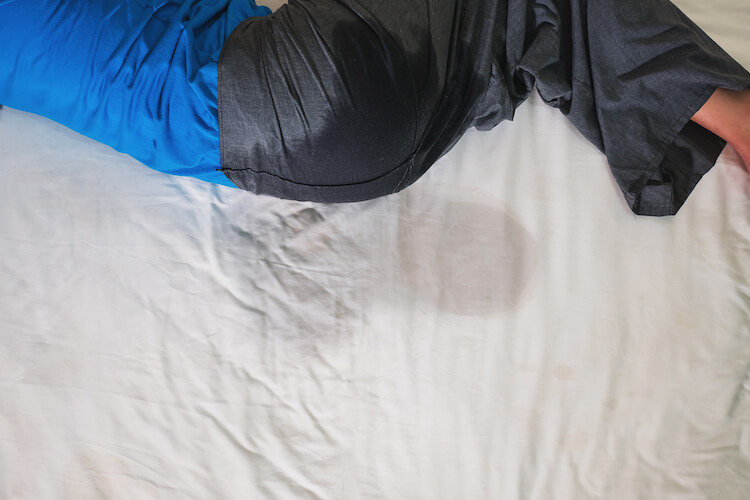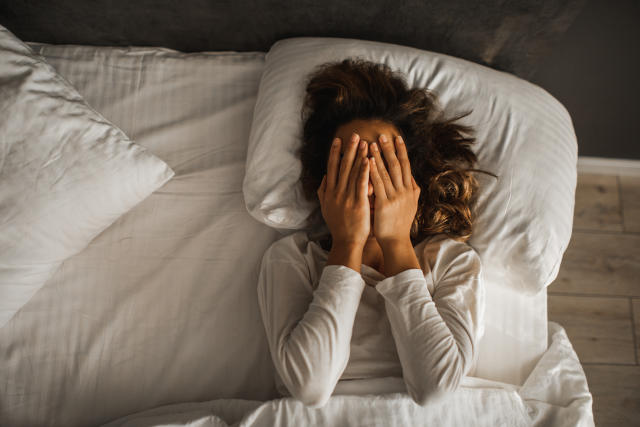The term “parasomnia” refers to aberrant activity that occurs before falling asleep, while asleep, or during the arousal phase between sleep and waking. The characteristics, severity, and frequency of these actions vary greatly.
Parasomnias were once thought to be a clear symptom of psychopathology, but some modern experts believe they occur as the brain transitions in and out of sleep, as well as between Rapid eye movement (REM) and Non-rapid eye movement (NREM) sleep cycles. Although parasomnias are more common in youngsters than in adults, similar behaviors have been observed in people of all ages.
You may move around, talk, or do weird things while sleeping if you have parasomnia. Others may believe you are awake, but you are actually sleeping. You usually have no recollection of the experience.
While parasomnias are prevalent, they can make getting a good night’s sleep challenging. Other people’s sleep may be disturbed as a result of your actions.
Furthermore, because you are oblivious of your surroundings, some parasomnias might be dangerous. They can also have negative health consequences, such as psychological stress. Parasomnias, like other sleep disorders, can be treated.
Parasomnia comes in a variety of forms. While each parasomnia has its own set of symptoms and diagnostic criteria, they can be divided into three categories: NREM-related, REM-related, and “other” are the three categories.
Parasomnias Caused by NREM
The first stage of one’s sleep cycle, referred to as “shallow” sleep, is followed by the second, third, and fourth stages, during which the sleep grows increasingly deeper. These stages normally last about 90 minutes in total.
Disorders of arousal are the most frequent NREM-related parasomnias. Recurrent episodes of incomplete awakening, limited responsiveness to other people attempting to help or redirect the sleeper, and poor cognition throughout the episode characterize these parasomnias. The majority of persons who suffer from arousal disorders have little to no remembrance of their bouts. These illnesses include:
1. Confusional Arousals
This occur when a sleeper demonstrates mental or behavioral disorientation in bed. Most people who have confusional arousals have very minimal autonomic arousal, such as mydriasis (dilated pupils), tachycardia (rapid heartbeat), tachypnea (rapid breathing), or sweating. Elpenor syndrome is another name for confusional arousals.
2. Sleepwalking
This is also known as somnambulism and is when a person gets out of bed while still asleep but shows little awareness of or reaction to their environment. Other sophisticated activities, such as sorting clothes, may be displayed. If the person loses their balance or collides with other objects while sleeping walking, they may sustain injury.
3. Sleep Terrors
People who have night terrors (also known as sleep terrors) scream in their sleep, but they are usually unresponsive to outside stimuli and have no recollection of the source of their terror when they wake up. The majority of night terror experiences last 30 seconds to three minutes.
4. Sexual aberrant actions
Also known as “sexsomnia,” this parasomnia subtype is characterized by atypical sexual behaviors while sleeping, such as aggressive masturbating, sexual intercourse initiation, and sexual noises.
Males and girls are equally susceptible to arousal problems, according to studies, while age appears to play a factor. In approximately 17% of children aged three to thirteen, parasomnias have been reported. The prevalence rate for children and people aged 15 and up is between 2.9 percent and 4.2 percent.
5. Sleep-related Eating Disorder
Another prevalent NREM-related parasomnia is sleep-related eating disorder, which is marked by periods of disordered eating following waking from sleep. During eating episodes, most patients with this illness have limited attentiveness and have little to no memory of what happened.
Parasomnias Caused by REM Sleep
Following the first four NREM stages of sleep, rapid eye movement sleep occurs. NREM and REM stages will repeat in a cyclical pattern every 90 minutes or so for the rest of the night after the first complete sleep cycle. REM sleep occurs when a person’s eyes move rapidly beneath their eyelids, as the term suggests4. They will also notice increased pulse rate and blood pressure, as well as quicker breathing.
The following are examples of REM-related parasomnias:
1. REM sleep behavior disorder (RSBD)
This is characterized by a typical vocalizations or movements during REM sleep, which are frequently in response to a dream. Skeletal muscle atonia, the excessively relaxed condition that occurs during the REM period, is frequently related to muscular dysfunction. Polysomnography studies, which monitor brain activity during the REM state, may be performed on people with RSBD. People over the age of 50 are more likely to have this illness. Patients taking certain anti-depressant medicines may show clinical signs of RSBD5.
People with recurrent isolated sleep paralysis have full body atrophy during sleep onset — the period just before falling asleep – or upon waking. During these episodes, which usually last only a few minutes, they will be unable to move any part of their body. Sleep paralysis can cause anxiety or discomfort when it comes to falling asleep.
2. Nightmare Disorder
Everyone experiences bad dreams once in a while. Nightmare disorder affects people who have recurrent, vivid dreams about threats to their survival or security, which cause exhaustion, discomfort, impaired cognition, and other problems throughout the day. Post-Traumatic Stress Disorder (PTSD) is known to include a nightmarish component. During nightmare episodes, motor activity is generally restricted. Severe psychosocial stressors are often to blame in children with nightmare condition.
Other Parasomnias
Behaviors that occur during the transition between sleep and waking, as well as those that can occur during NREM or REM sleep, are classified as “other” parasomnias. The following are examples of parasomnias:
1. People with Exploding Head Syndrome
Also known as sensory sleep. It begins with wake up hearing a loud boom or feeling an exploding sensation in their head. Upon waking, they may also “see” an imagined flash of light. The sleeper may experience palpitation, dread, or worry as a result of this sensation, but it is usually painless. Some people may have many episodes in a single night.
2. Hallucinations Associated to Sleep
People with this condition have hallucinations either while they fall asleep (hypnagogic) or when they wake up (hypnagogic) (hypnopompic). Visual, aural, tactile, or kinetic hallucinations are all possible. Sleepers may abandon their bed in an attempt to escape what they are experiencing in extreme circumstances. After the sleeper awakens, the hallucinations may last for several minutes.
3. Enuresis During Sleep
Sleep enuresis, sometimes known as “bedwetting,” is the involuntary urine that occurs during sleep. In young children, bedwetting is extremely common. Parasomnia must occur in people aged five and up at least twice per week for at least three months to be termed a parasomnia. People with primary sleep enuresis never wake up feeling dry.

Causes of Parasomnia
Parasomnia can be caused by a variety of factors. Multiple triggers have been linked to the disease, including:
- Stress
- Anxiety
- Depression
- PTSD
- Substance use
- Certain medications
- Irregular sleep schedules, like shift work
- Other sleep disorders, like insomnia
- Sleep deprivation
- Neurological conditions, like Parkinson’s disease
Children’s Parasomnia
Children are more likely than adults to suffer from parasomnia. It’s especially common in youngsters with neurological or mental disorders, such as epilepsy or attention deficit hyperactivity disorder (ADHD).
Stress and sleep deprivation can also cause parasomnia in children. Parasomnia in children, on the other hand, is frequently caused by an immature sleep-wake cycle. The distinction between alertness and sleep is thus blurred, resulting in a mixed state of awareness.
By adolescence, the majority of youngsters have outgrown it. Children with parasomnia may experience more sobbing and dread than adults. They can be afraid about going to bed alone.
If your child exhibits unusual sleeping habits, keep in mind that they are not doing so on purpose. Instead of punishing them, focus on being supportive. For example, encourage them to use the bathroom before bedtime, if they wet the bed.
Symptoms of Parasomnia
Parasomnia can induce a variety of symptoms in addition to irregular sleep habits. You could:
- When you wake up, you may be bewildered or disoriented.
- When you wake up, you’re not sure where you are.
- I don’t recall doing some things
- Discover new cuts on your body
- Have a hard time sleeping through the night
- Drowsiness or weariness during the day.
Management for Parasomnia
Cognitive behavioral therapy (CBT)
A frequent parasomnia treatment is cognitive behavioral therapy (CBT). This is due to the fact that parasomnia is frequently linked to mental health issues such as stress and anxiety.
Other techniques that can be used in conjunction with CBT include:
- Psychotherapy
- Relaxation therapy
- Hypnosis
Home Management
Some treatments can be carried out in the comfort of your own home. Your doctor may advise you to:
- Schedule your awakening: Scheduled awakenings occur when you wake your child up 15 to 30 minutes before they wake up naturally. It may aid in the reduction of repetitive behaviors. It’s frequently prescribed to treat sleepwalking and night terrors.
- Keep your sleeping surroundings safe: You may need to sleep alone or remove unsafe things from your home if you sleepwalk. You can also sleep with more cushioning by locking windows and doors, putting the mattress on the floor, and locking the windows and doors.
Bottom Line
Parasomnia can make it difficult to get a good night’s sleep. Due to a lack of sleep, it may also raise the risk of accidents and health problems. Parasomnia is treatable and so it is necessary to contact a sleep doctor if you’re experiencing a typical sleeping patterns. They can look into the root reasons of your symptoms and prescribe the best remedy.
